Content
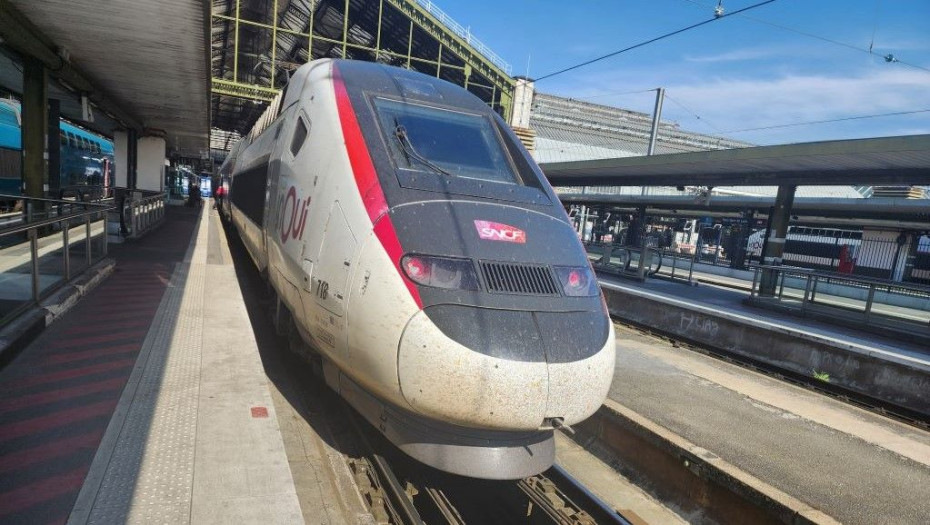
TGV InOui (Duplex)
Welcome to the guide to travelling by these iconic high speed trains in France.
Share
At a Glance
Travel Pass Supplement
Rail Pass Reservation Fees
Reservations
Compulsory
Time of Day
Day
Catering
Food services available
Bistro (bar food and take away meals)
Accessibility
Accessing the train
Wheelchair Spaces
Bikes Allowed
Train Specification
Attributes of the train
Double Deck
Has a Conductor
High Speed (total journey)
High Speed (partial journey)
Country
Which country these trains operate in.
France
Travel Passes
Eurail
Interrail
On Board
Première/Premium/1ére
Perks
WiFi
A complimentary WiFi portal is available throughout this train.
Power Socket
The power sockets on this train are compatible with standard E.U. two point plugs.
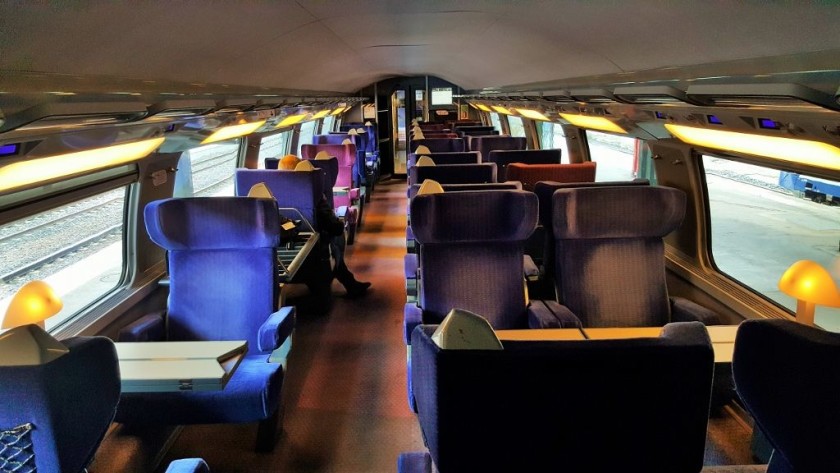


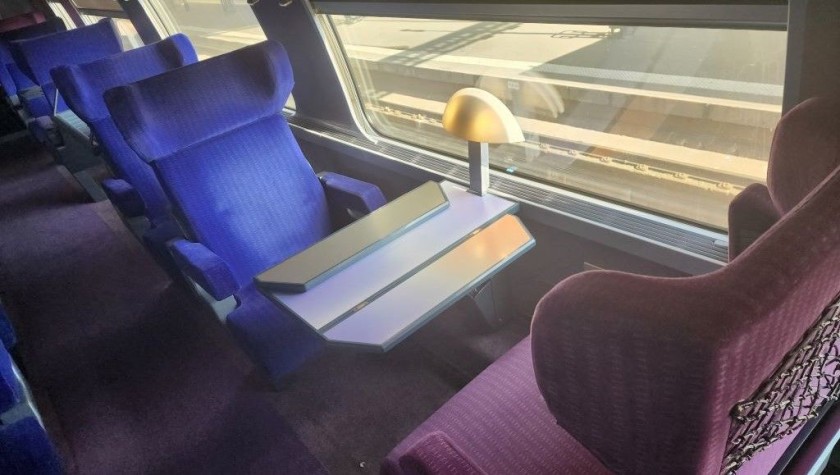
The services that are branded 'InOui' also offer Business Premiére Class in addition to regular Premiére/1st class.
Seconde/Standard/2nde
Perks
WiFi
A complimentary WiFi portal is available throughout this train.
Power Socket
The refurbished 'InOui' trains now have power sockets in Seconde / Standard Class
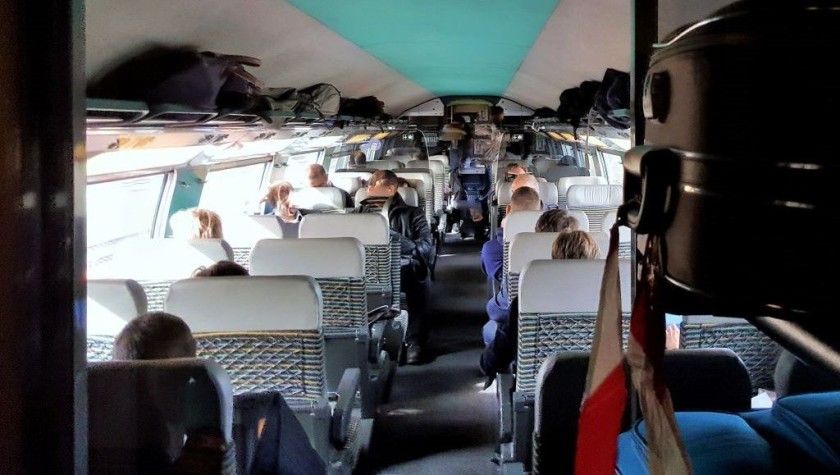
Good to know info
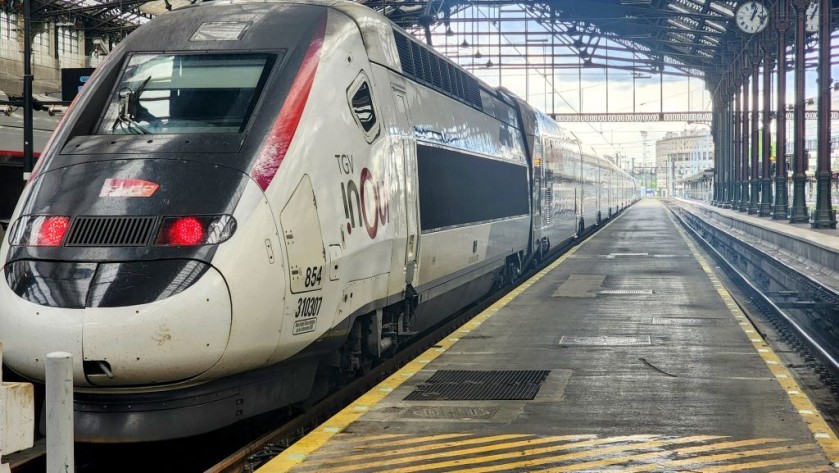
ShowMeTheJourney has anticipated what questions are most often asked about travelling on the most common type of TGV InOui Duplex (double-deck) train and answered them below.
If you can't find the information you are seeking, you can ask a question and the AI enabled service will try to write an answer, telling you what you wish to know.
How fast does the train travel?
When in service these trains have a theoretical top speed of 320 km/h (198 mph), but this speed is most typically achieved on the LGV Est européenne used by trains travelling between Paris and Metz, Nancy, Colmar and Strasbourg
On the other high speed lines they typically travel at up to around 300 km/h.
Are seats allocated when booking tickets?
Yes.
Can specific seats be selected from a seating plan?
This is possible when booking Premiere, or Business Premiere tickets on SNCF Connect.
See the ShowMeTheJourney guide on how to book on SNCF Connect.
When booking Seconde tickets, you can select a seat location - lower deck or upper deck, window or aisle etc.
Can I choose forward facing seats?
Not on this type of TGV.
(Trains reverse direction when calling at Marseille St Charles during a journey).
Do Eurail / InterRail Pass users need to make reservations?
Yes, seat reservations are mandatory when travelling with rail passes on all TGV services.
See the guide to using rail passes in France
Note that the same fees are payable by holders of both First and Second class rail passes.
What catering is available on the train?
The trains have a bar/ bistro service - see the Catering section below for more info.
More detailed info has also been produced by SNCF Connect.
Are power sockets available?
Yes - at all seats, for standard E.U. 2-point plugs.
Is Wi-Fi available?
Yes and more info on how to connect is available here.
Is a Quiet Coach available?
No, the French national rail operator does not have a policy of offering coaches in which mobile phone usage etc is not permitted.
What is the luggage policy?
You must be able to carry all your luggage alone at one time.
You can take either:
2 suitcases + 1 hand luggage
OR
1 suitcase + 1 special baggage + 1 hand baggage
Your hand luggage can measure a maximum of 40 cm x 30 cm x 15 cm.
Your suitcase can measure a maximum of 90 cm x 70 cm x 50 cm
Your special luggage (musical instrument, bicycle under cover, folded bicycle, scooter) can measure a maximum of 130 cm x 90 cm. Bicycles, musical instruments, and snowboards, skis, must be in a labeled cover.
More info is available on the SNCF Connect website.
Are wheelchair spaces available?
Yes, they are housed on the lower deck in a Premier / 1st class coach.
More info is available on the SNCF Mobility Services guide.
Can non-folding bicycles be taken on board?
Yes, but spaces must be reserved prior to boarding.
When booking tickets on SNCF Connect you can add a bike symbol to the search, so will then see which departures have bike spaces available - taking a bike on board requires an additional ticket.
See the ShowMeTheJourney guide on how to book on SNCF Connect.
What’s also worth knowing is that you can’t book Premiére/1st class tickets for journeys by these trains if you want to travel with a bike; presumably because the bike storage on these trains isn’t adjacent to the Premiére Class seating areas.
Can dogs be taken on board?
One dog per person, non guided dogs are charged €7, smaller dogs must travel in containers, larger dogs must be muzzled.
More info is available on the SNCF Guide.
TGV Duplex travel guide:
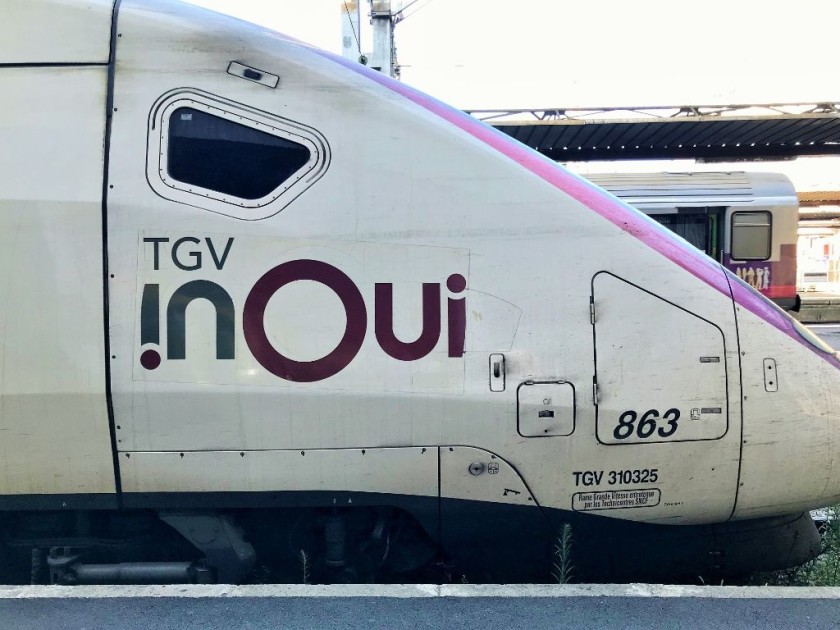
TGV Duplex trains are the iconic double-decked French high speed trains which travel up to 320 khm/h.
Though now that the TGV Océane trains have been introduced, they're no longer the only type of double-deck high speed train used in France.
Our insights to travelling by TV Duplex trains will guide through the travelling experience, from boarding the train to making the most of the journey.
The majority of French cities are served by these TGV Duplex trains as they are used across on France on all the high speed lines - the LGV network
The French national operator embarked on a refurbishment program of these trains and the modernised trains were re-branded as 'InOui' services.
Routes:
TGV Duplex trains are used on mostl TGV services between Paris and cities in south east France including Lyon, Marseille, Nice and Montpellier - and beyond.
Take one of one of the direct trains between Lille and destinations to the south of Paris and it's likely that you will be travelling on a TGV Duplex.
You won’t know for certain if you will be travelling on a TGV Duplex until you book a ticket and are offered a choice of travelling in the upper or lower decks - you can also confirm which type of TGV will be used on a specific departure using this guide.
On these routes, you will almost certainly be travelling on a TGV Duplex train:
(1) All TGV InOui services from Paris Gare De Lyon to these destinations in France, south of Dijon -Avignon, Annecy, Chambery, Grenoble, Lyon, Marseill and ,and most services to and from both Montpellier and Perpignan.
(2) Lille <> Bordeaux and Lyon and Marseille and Montpellier and Nice and Rennes and Nantes
(3) Montpellier/Marseille/Lyon <> Nantes/Rennes and Strasbourg
This type of of train is also used on some departures on these routes:
(1) Paris Est - Nancy and Metz and Strasbourg
(2) Paris Nord - Lille (usually on the services which don't travel beyond Lille)
(3) Toulouse - Lyon via Montpellier
(4) Paris Montparnasse - Bordeaux (some of the slower services via Poitiers and Angouleme)
Many services operated by TGVs extend beyond the LGVs (high speed lines), so between certain cities, including;
Marseille – Nice,
Nimes – Perpignan,
Bordeaux – Toulouse,
Mulhouse – Strasbourg, the TGVs only use conventional tracks.
Reservations (& Using rail passes)
Seats will automatically be assigned when booking tickets for journeys by TGV train.
Rail pass users will need to have made reservations prior to boarding and info on how to book these rail pass reservations is available HERE.
Boarding:
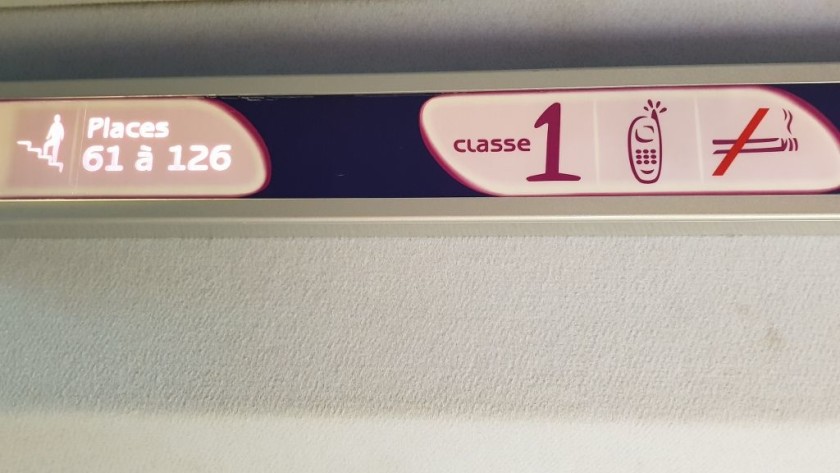
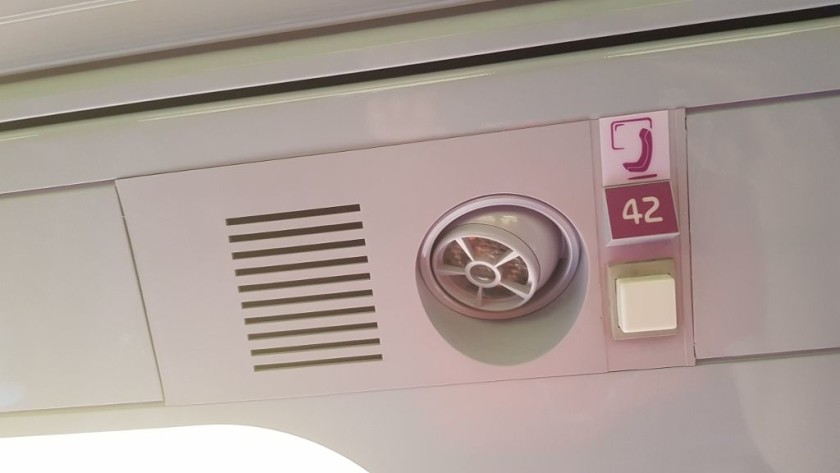
These trains have 8 coaches/carriages, but two trains are often joined together, so some train departures are formed of exceptionally long trains.
Therefore aim to be at the station at least 8 minutes before departure, particularly if you will be joining the train at an intermediate station.
Before arriving on the voie/platform/track, check your ticket and find the number of the coach in which your reserved seat is located.
Then use the info screens on the voie/platform, to check in which zone on the voie you should wait in, for easy boarding into your coach.
Two trains are often joined together for most of the journey, but the train then splits so different final destinations can be served.
In these instances each part of the train has separate train numbers.
When two trains are joined together, it isn’t possible to walk entirely through the train from one end to the other.
Another good reason for not boarding by the first door you see because you are rushing.
The coach/carriage numbers can be hard to spot as they are on the electronic info panel set into the body work of the train by the door.
The coach numbers aren't included on the interior, so try and take your time and check that you are boarding into the coach in which your reserved seat is located.
On the grey/white liveried trains, a large 1 by the door indicates a 1st class carriage, while a 2 indicates a 2nd class carriage.
On the blue/grey TGV Duplex trains a green coloured slash across the door indicates that a coach/carriage is 2nd class - ‘2nde’ is also written to the left of the door.
A pink slash indicates a door to a 1st class coach/carriage and ‘1ére’ will be written by the door.
As you step on to the train, look out for the easy to miss signs, located above your head, that indicate which seat numbers are on the lower and upper decks.
Keep your ticket where you can access it easily, so that you can check your seat number as you enter the seating saloon.
The sequence of numbers can seem illogical, so take your time.
The window seat numbers are above the windows, by the lights.
What you won’t see is any indication of the stations between which the seat is reserved for, all you have to do is look for the seat numbers and match it to the seat number on your ticket.
If you don’t have luggage with you, hang back and be amongst the last passengers to board.
All seats are reserved, so you won’t risk having no seat to travel in, and you can avoid being caught up in the scramble for luggage space.
Managing luggage:
The luggage allowance = 2 suitcases/large bags + 1 item of hand luggage per person.
If you have large items of luggage, don’t be tempted to locate your seat first, and then work out where to stow your luggage.
On both the lower and upper decks you have to walk by the main luggage racks to access the seating saloons.
If there's space on these racks then the advice is to make use of it - if you're prepared to accept that you won't be able to see your bags from your seat.
Luggage space is limited in the 2nd class seating saloon, but if you've entered by the door to the coach in which you seat is located, then alternative luggage racks are located at the far end of the seating saloon.
The above seat luggage racks are particularly small, and won’t accommodate items much larger than a large handbag.
Medium size bags will fit in the space between some of the seats.
The lower decks have more areas in which bags can be stowed away, but if you are travelling 1st class avoid utilising the space set aside for wheelchair users.
There is generally more space in which to stow luggage in 1st class - in the 1st class upper deck there are also racks in the middle of the seating area that can accommodate large items
On board:
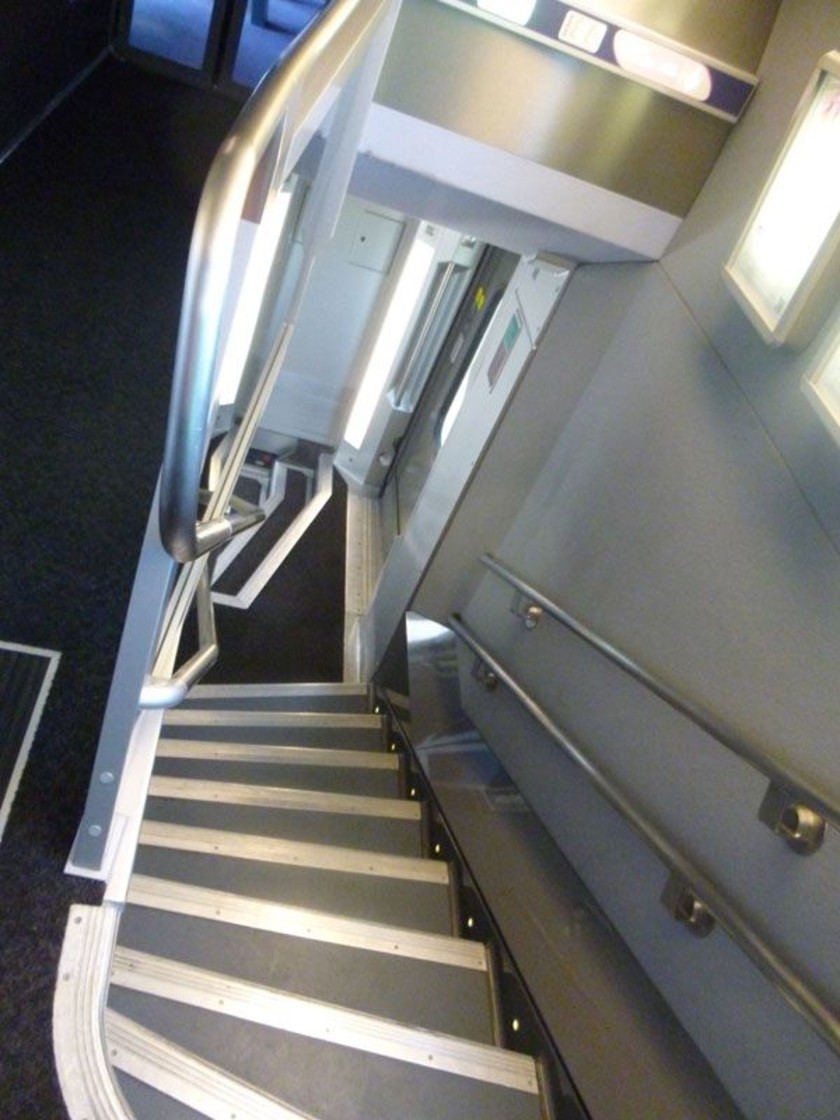
Seating Plan (in French)
On board announcements can be in the French language only, but the conductors usually speak English, so you can verify any questions when they pass through the train to check tickets.
Modernised TGV Duplex trains are classified as providing a 'TGV InOui' service with the key passenger benefit being enhanced wi-fi connectivity, also more power sockets have been added in Seconde/Class.
If you won't be travelling on an InOui service, the wi-fi connectivity can be patchy, theoretically it's available on the high speed lines.
In addition to being available by1st class seats, power sockets are also available in the platforms/vestibules between coaches - passengers are encouraged to use these spaces between coaches to make mobile calls.
On services classified as InOui power sockets can also be available at Seconde/2nd class seats.
Staircases link the lower and upper levels and there are toilets on both levels in each coach
However, if you want to access the bar counter, then it’s easier to move through the train at the upper level, as the serving counter is on the upper deck.
The upper deck inevitably offers better views, as they enable passengers to see over the sound barriers that line much of the track.
However, the scenery that can be seen from a French high speed line is rarely scintillating.
Don't presume that because the double decking allows for more seats per train, that the seating will be particularly roomy, the area per seat is no more spacious than on a single deck TGV.
Target the lower deck if you have luggage and/or if you are tall - the lower deck can feel more spacious.
If you are tall and sat by the window on the upper deck, take care not to bang your head on the ceiling when you leave the seat.
Travelling with Children
When booking on the SNCF Connect website if you include children (aged 12 an under) in the travel party, you can be offered specific types of reservations. - How to use SNCF Connect.
Regardless of whether you will be booking the equivalents of 1st or 2nd class tickets, you may be offered a Family Carré booking, which will reserve the four seats at a table.
Though obviously this is subject to availability, particularly as most of the seats on these trains are arranged airline style, so are not at tables.
When travelling at weekends, during school holidays and on national public holidays, an area in a 2nd class coach on these trains is designated as a Family Space.
If places are still available, you can opt to book seats in this space.
For those travelling with babies there is also a nursery area in 2nd class located near the Family Area. From here you can also access the universal toilets (adapted for wheelchair users), which are in 1st class, as the are also equipped with a changing table.
Catering:
There is no trolley service on TGV trains so you will need to go the bar coach if you want to purchase food and drink – though don’t over rely on it having all items available to purchase.
The at-seat catering service on most TGV trains is only available if you order meals to be delivered to your seat prior to boarding.
The first stage of this catering booking service is to enter the train number (not the departure time) which will be on your ticket, into this order form.
Though purchasers of Business Première tickets will receive an at seat catering service when travelling between Paris and Lyon.
Take care with food and drink, particularly un-opened bottles and drinks in cups and glasses.
When the trains corner at high speed, drinks and food can fly off the table.
Bicycles:
In a major recent change, non-folding bikes can now be taken on TGV Duplex trains, places must be reserved prior to boarding for a fee of €10.
Though travelling in Premiere / 1st class isn't possible if you want to travel with a non-folding bicycle.
This second version of ShowMeTheJourney is exciting and new, so we are genuinely thrilled that you are here and reading this, but we also need your help.
We’re striving not to let anything get in the way of providing the most useful service possible, hence a facility has been set up with DonorBox which can be used to support the running costs and make improvements.
Instead of advertising or paywalls, your financial support will make a positive difference to delivering an enhanced service, as there’s a lot of ideas which we want to make happen.
So if you have found the info provided here to be useful, please consider saying thank you.

This is one of more than 100 train travel guides available on ShowMeTheJourney, which will make it easier to take the train journeys you want or need to make. As always, all images were captured on trips taken by ShowMeTheJourney.






